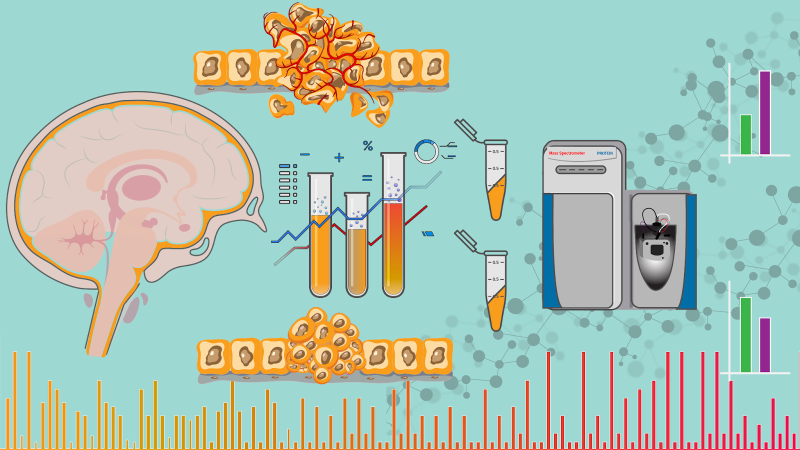
A multi-institutional study has identified a set of proteins that can potentially predict whether meningioma, a kind of brain tumour, is low- or high-grade (less or more aggressive) with around 80% accuracy. The proteins were tested in tumour and blood samples. They hold promise as biomarkers for early diagnosis and prognosis of meningiomas.
Meningiomas, the most common form of brain tumour, pose a growing challenge for clinicians due to their increasing prevalence and the difficulty in identifying patients who are at risk of developing a more aggressive form of the tumour. Leveraging a long-standing collaboration with clinicians from Tata Memorial Hospital and ACTREC (Advanced Centre for Treatment, Research and Education in Cancer), Navi Mumbai, researchers at the Indian Institute of Technology Bombay (IIT Bombay) identified a critical gap: the lack of reliable markers for early detection of meningioma patients transitioning to a more aggressive tumour state. And this is despite extensive advances in proteomics – a type of large-scale study that looks at the entire set of proteins in a biological sample – including proteomic studies specifically on meningioma.
To address this gap between research and patient care in meningioma diagnosis, a collaborative team was formed, bringing together experts from IIT Bombay, the Institute for Systems Biology, Seattle, and the Medical Technology Research Centre, Anglia Ruskin University, Cambridge, alongside the aforementioned clinicians, under the leadership of Prof. Sanjeeva Srivastava from IIT Bombay. Their study aims to unlock new clinical insights by classifying meningioma grades in, both, blood (serum) and tissue samples. It conducts a comparative analysis of potential protein biomarkers in the serum and tissues of healthy individuals, those with high- and low-grade meningiomas, and individuals with glioblastomas (a different, aggressive, type of brain tumour).
The researchers examined 53 tissue samples and 51 blood samples collected from Indian participants. These included samples from individuals with no brain tumour (healthy), those with glioblastomas, and those diagnosed with low- and high-grade meningioma. The glioblastoma samples served as a comparison set of samples in the study – because glioblastoma is a brain tumour originating from a different set of cells in the brain than meningioma. The researchers thus tried to ensure that the markers are unique to meningioma by comparing the expression pattern of the same in glioblastoma.
The team examined existing scientific research and databases and identified proteins associated with meningioma. From this initial list, they then narrowed their focus to 49 proteins in tissue samples and 24 in blood samples for further analysis using mass spectrometry.
Analysing tumour proteomes is challenging, primarily because a tumour tissue sample will contain cells of different kinds. There could be normal cells and there could be cancer cells with varying grades – from low to high. This heterogeneity within tumours often leads to a high degree of overlap between healthy and diseased samples. To address this challenge, the researchers in this study focused only on specific proteins that were previously reported to be improperly regulated in meningioma and then evaluated whether their levels varied considerably between low- and high-grade tumours.
While the analysis of the tumour samples could allow a clear distinction between healthy and diseased tissue, as well as meningioma from glioblastoma (suggesting that despite both being brain tumours, they have different protein signatures), it proved challenging to differentiate between low-grade and high-grade meningioma. Difficulty in differentiating between the grades, at a molecular level, could be due to the heterogeneous nature of tumours or because the tumour itself is transitioning from a lower grade to a higher grade, harbouring cells of varying grades.
The serum samples, however, showed a relatively clearer distinction between low- and high-grade meningioma. Interestingly, (and contrastingly), the high-grade meningioma showed greater similarities with glioblastoma than with low-grade meningioma in their protein profiles, highlighting potential commonalities between the two aggressive brain tumours (i.e., glioblastoma and high-grade meningioma).
The study identified proteins such as Profilin 1, Annexin A1 and S100 calcium-binding protein A11 as more abundantly present in high-grade meningioma compared to low-grade, while certain proteins including Plectin and Mucins were present in lower amounts in high-grade meningioma compared to low-grade. Similarly, proteins such as Transferrin, Gelsolin, APOB were found to be present in lower levels in the serum samples collected from high grade Meningioma patients.
Following this analysis, the researchers narrowed down the list of proteins to 15 proteins in tissue and 12 in blood, for further investigation, focusing on those showing the most significant variation. They used these selected protein markers to build a machine-learning model that could distinguish low-grade from high-grade meningioma. Ankit Halder, one of the lead authors of this study, enthused about how integrating artificial intelligence and machine learning in omics research has significantly impacted and streamlined their research.
In tissue samples, a combination of Mucin proteins, MUC4 with MUC1, and Spectrin beta chain with S100 calcium-binding protein A11 showed the best distinction as markers. Similarly, in serum samples, combinations of proteins such as Transferrin with Fibronectin and Apolipoprotein B showed promising results in distinguishing low-grade from high-grade tumours.
Further studies on both the molecular and clinical fronts are undoubtedly crucial before definitively establishing any of these proteins as biomarkers. At the molecular level, for instance, the researchers are intrigued by the presence of Transferrin, in their results derived for meningioma. Transferrin has been identified as an essential factor inducing a newly discovered iron-dependent cell-death process, and recent studies suggest its involvement in the development of various diseases like tumours.
At a clinical level, each biomarker discovered in this study requires further analysis and validation on larger cohorts.
“The meningioma project is an ongoing endeavour with many facets left to explore. Our goal is to assist clinicians in identifying and managing patients by monitoring these markers,” Halder concluded.






